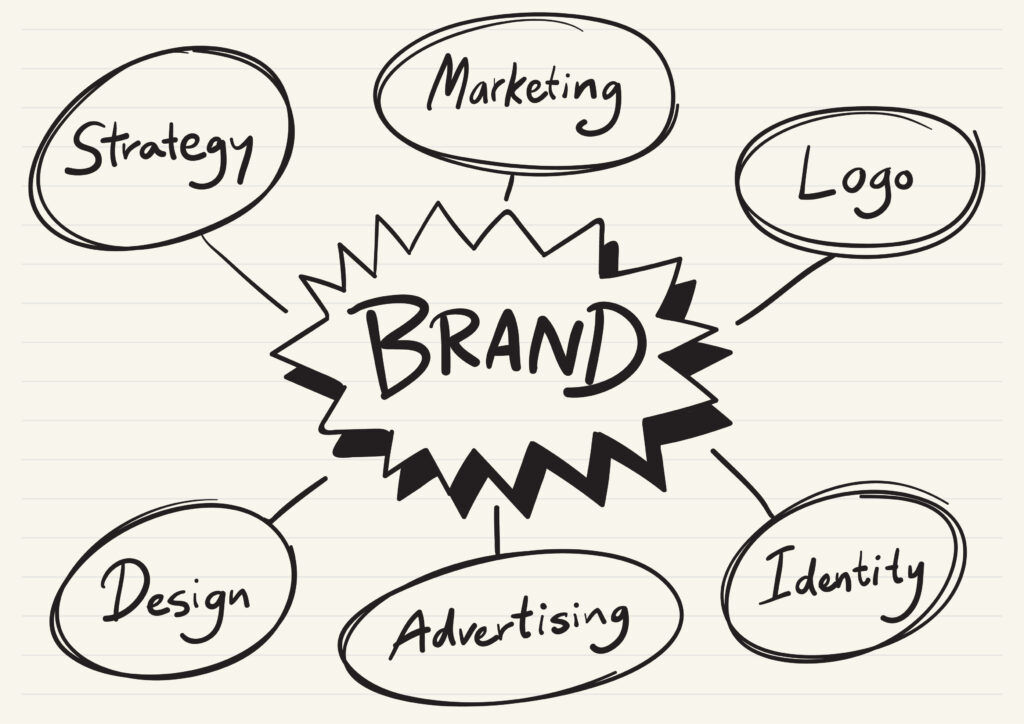
Have you ever wondered why some companies stand out effortlessly while others struggle to gain recognition? What’s the secret behind those instantly recognizable logos and memorable slogans?
It’s due to branding, but what is branding?
Branding is the strategic process of producing a unique and consistent business identity. It encompasses everything from visual elements to the emotions it evokes in consumers.
In this blog post, we will delve into the essence of branding, explore why it is crucial for small businesses, and provide insights into how you can develop and implement a powerful brand strategy.
What is Branding?
At its core, branding encompasses much more than just a logo or a catchy slogan. It’s the identity of your business – a composite of its values, voice, visual elements, and the emotions it evokes in customers.
So, what is branding in business? It’s the strategic process of creating a precise and memorable impact in the minds of consumers.
This includes everything from visual aspects like colors and fonts to intangible elements such as customer service and corporate culture.
A successful brand tells a story and conveys a promise to its audience. It’s how your company communicates its mission and values, differentiates itself from competitors, and establishes a lasting connection with its customers.
Branding defines who you are as a business, what you stand for, and how you want to be perceived.
Why is Branding Important?
Let’s explore the importance of branding. Branding holds immense significance in the modern business landscape for several key reasons:
1. Differentiation and Recognition: A strong brand helps a business stand out to its customers and makes it memorable and recognizable.
2. Influencing Purchasing Decisions: Branding can be the deciding factor for consumers when purchasing. According to the Razorfish study in 2021, 82% of surveyed consumers buy from brands with a greater purpose.
3. Creating an Identity: Branding represents an identity that consumers depict, relate, and connect with beyond the product or service they purchase.
4. Building Trust and Credibility: A strong brand communicates a clear and consistent message that resounds with its target audience, creating an emotional connection and engendering trust and credibility.
5. Enhancing Marketing Efforts: Effective branding can enhance the impact of marketing efforts by creating a strong emotional connection and trust with customers, leading to more successful marketing campaigns.
6. Fostering Customer Loyalty: A strong brand can help attract and retain loyal customers, as customers mostly prefer brands they recognize and trust.
7. Long-term Business Growth: Branding is a business’s long-term investment growth and feasibility. It lays the foundation for consistent growth and opens doors to new opportunities.
The Elements of Effective Branding

To grasp what branding is and why branding is important, it’s essential to understand the key elements that constitute effective branding:
1. Brand Voice: Your brand voice is how you communicate with your audience. It should reflect your brand’s personality and values, whether professional, friendly, authoritative, or quirky.
2. Brand Promise: Your brand promise is the quality assurance and experience customers expect from you. It needs to be consistently fulfilled.
3. Brand Positioning: This defines how your brand differentiates itself from competitors and where it fits in the marketplace. Effective positioning highlights your unique selling proposition (USP) and resonates with your target audience.
4. Brand Experience: Every customer interaction with your brand contributes to the overall brand experience. This includes not only the product or service itself but also customer service, packaging, website navigation, and even social media engagement.
Real-World Examples of Powerful Branding
Consider some of the world’s most successful brands. Apple, for example, has cultivated a brand that stands for innovation, quality, and a seamless user experience.
Its sleek design, intuitive products, and minimalist marketing consistently communicate these values, creating a loyal customer base anticipating each new release.
Nike, another prime example, has built a brand around the spirit of athleticism and empowerment.
With its iconic “Just Do It” slogan, Nike inspires and motivates its customers, fostering a community of athletes and fitness enthusiasts representing their brand’s message.
Brand Strategy and Guidelines
A strong brand strategy and well-defined guidelines are essential for constructing a consistent and memorable brand identity.
Here’s a comprehensive guide to help you develop your brand strategy and guidelines:
1. Brand Strategy: Develop a clear brand strategy for your business goals and target audience.
2. Brand Identity: Define your brand’s unique personality, values, and voice to create a consistent brand identity.
3. Visual Branding: Create a cohesive visual identity with a logo, color palette, typography, and imagery that reflects your brand.
4. Messaging: Craft compelling brand messaging that aligns with your target audience and speaks about your brand’s value proposition.
5. Consistency: Ensure consistency in all brand touchpoints, from marketing materials to customer interactions.
6. Brand Guidelines: Document brand guidelines that lay out how your brand should be represented across all channels.
7. Monitoring and Adaptation: Regularly monitor brand performance and adapt strategies to stay relevant and resonate with your audience.
8. Employee Training: Educate employees on brand guidelines to ensure consistent brand representation.
How to Create a Brand
Creating a successful brand involves a strategic and thoughtful approach. Here are the key steps to help you build a strong brand identity:
1. Research and Planning
- Define Your Purpose: Clarify your brand’s mission, vision, and values.
- Know Your Audience: Conduct market research for your brand and understand your target audience’s needs and preferences.
- Competitor Analysis: Identify your competitors and determine how you can differentiate your brand.
2. Brand Identity Development
- Brand Name: Select a unique and catchy name that reflects your brand’s essence.
- Logo Design: Create a visually appealing logo that represents your brand.
- Color Palette: Select colors that convey the right emotions and align with your brand’s personality.
- Typography: Choose fonts that complement your brand’s style and are easy to read.
- Visual Elements: Create a consistent visual style for imagery, graphics, and other design elements.
3. Brand Messaging and Communication
- Brand Story: Generate a compelling narrative communicating your brand’s history, values, and mission.
- Key Messages: Define clear and consistent messages that convey your brand’s unique selling points.
- The tone of Voice: Produce a tone that relates to your target audience and depicts your brand’s personality.
- Content Strategy: Plan how to communicate your brand message across different channels.
4. Brand Guidelines and Implementation
- Document Brand Guidelines: Create a comprehensive guide outlining how your brand must be represented visually and verbally.
- Consistent Branding: Ensure your brand is unfailingly applied across all touchpoints, from your website to social media.
- Employee Training: Educate your team on the brand guidelines to maintain brand consistency.
- Monitor and Adapt: Review and adjust your brand strategy regularly according to feedback and market trends.
Branding Tips for Small Businesses
Branding is essential for small businesses, as it can help them stand out from the competition and attract new customers.
Here are some tips for small businesses looking to build a strong brand:
- Begin with a clear brand identity: Define your business’s values, personality, and target audience.
- Develop a strong brand message: Communicate in a way that makes your business unique and allure customers to choose you.
- Do consistent branding across all touchpoints: Ensure your brand is consistent across all your marketing materials.
- Be consistent with your branding over time: Allow your brand to evolve slowly and organically as your business grows and changes.
- Measure the results of your branding: Track the impact of your branding efforts on customer loyalty, brand recognition, and business growth.
The Path Forward: Building Your Brand
Now that we’ve explored what branding is and why it is essential, it’s time to consider how to develop and strengthen your brand. Here are some steps to get you started:
1. Define Your Brand: Clarify your mission, vision, and values. Understand what makes your business unique and how you want to be perceived by your audience.
2. Know Your Audience: Conduct market research to understand your target audience’s needs, preferences, and behaviors. Your branding efforts must resonate with them.
3. Create a Consistent Brand Identity: Develop a cohesive visual and verbal identity that depicts your brand’s personality. Ensure consistency across all touchpoints, from your website to social media to physical stores.
4. Deliver on Your Promise: Consistency in delivering your brand promise builds trust. Ensure every customer interaction aligns with your brand values and expectations.
5. Engage and Evolve: Engage with your audience regularly and be open to feedback. Brands that evolve and adapt to changing market conditions and consumer preferences stay relevant.
Conclusion: The Imperative of Branding
Branding is far more than an aesthetic exercise; it is a strategic imperative that grows your business. It shapes customer perceptions, builds loyalty, differentiates you from competitors, and adds significant value to your business.
As the market continues to evolve, branding will only grow in importance, becoming an essential focus for businesses of all sizes.
Ready to take your branding to the next level? Start by defining your unique brand identity and consistently delivering on your brand promise. Need help with your branding strategy? Contact us today to discover how we can help you build a brand that stands out and resonates with your audience.
Read More:

Vince Logo Design is a distinguished digital marketing agency, specializing in crafting compelling brand identities and optimizing online presence. We are your partners in creating impactful digital strategies that drive results.
Get in touch.Get Free Consultancy
Fill the following form and receive a guaranteed response within 48 hours.
We have worked with world's leading brands











